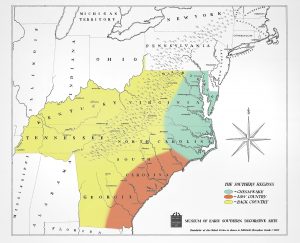This year marks a personal milestone: I have now lived in North Carolina longer than I’ve lived anywhere else. The South has been my home for over twenty years, and I hope never to leave. It is with great pride that I say that, while I may not be a southerner by birth, I am a southerner by choice!
This tidbit of information about your dear editor is revealed in order to place into context my embarrassment when I explained to Judith Cushman Hammer that I had not visited Blandwood, the subject of Judith’s article in this year’s MESDA Journal. Located in Greensboro, only thirty miles from my home in Winston-Salem, Blandwood is the residence of North Carolina Governor John Motley Morehead that was significantly updated in the 1840s by the renowned architect Alexander Jackson Davis. My face reddened even further as I learned from Judith about the history of the mansion and also about the remarkable surviving correspondences between Morehead and Davis. Judith’s article emphasized for me that a visit to Blandwood was indeed overdue. I hope it prompts a visit from you, too.
Perhaps one reason for my not recognizing a nearby architectural gem such as Blandwood is because I’ve spent a sizable amount of my time traveling throughout MESDA’s South. From Maryland down to Georgia out to the Mississippi boundaries of Tennessee and Kentucky, the region covered by MESDA is quite substantial. The geographic distances in one state alone, Tennessee, were a hurdle for authors Janet Hasson and Jennifer Core. In their article on the ornamental arts and girlhood education in Tennessee, Janet and Jennifer canvassed all three distinct regions of the Volunteer State: East, Middle, and West Tennessee. And while Amy Bertsch’s investigations of the pottery of the Gardner-Duncan Family (to be published later in the year) focuses on Loudoun County, Virginia, her work reveals techniques and trade networks that reach from Alexandria and the District of Columbia all the way into the Shenandoah Valley.
Following MESDA’s map as far north as one can go, Sumpter Priddy’s investigation of a group of clocks took him to Brooke County in the Northern Panhandle of West Virginia. Sumpter’s article identifies the clock cases as the work of Wellsburg cabinetmaker John Brown. Technically located above the Mason-Dixon line, but still firmly within a southern context, the Wellsburg shop of John Brown exemplifies the commercial influence of Eastern settlers heading west to the Mississippi Valley.
Coming back home to Winston-Salem, this year’s MESDA Journal also includes an article by Old Salem’s emeritus archaeologist Michael “Mo” Hartley about what is likely the first map of the Moravian tract of land in North Carolina that came to be known as Wachovia (again, this article will be published in the near future). In his article, Mo establishes that the map was drawn by Andreas Hoger during the 1754 surveys of Wachovia and was used to create a more finished map by Hoeger that survives in the museum’s collection. The 1754 work map was acquired by Old Salem in 2018 and can now be viewed next to the finished map that Hoeger drew after completing the surveys.
So please plan a trip to Piedmont North Carolina soon to see Blandwood and the Hoeger maps at Old Salem.
Happy reading!
With best regards,

Gary Albert
Editor
[email protected]

